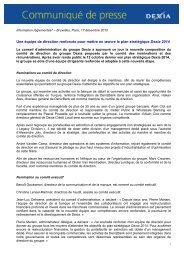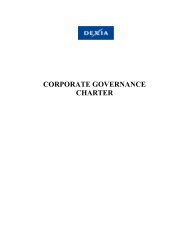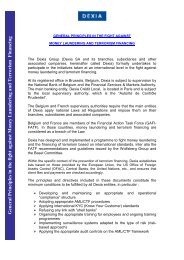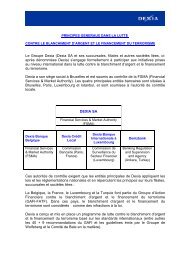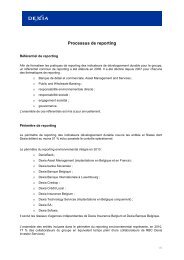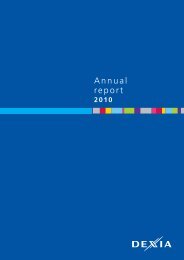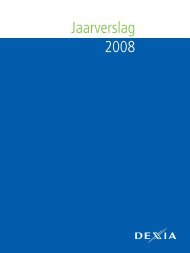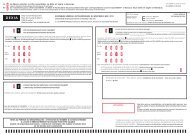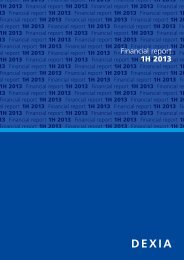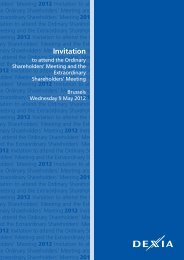Annual report 2006 - Dexia.com
Annual report 2006 - Dexia.com
Annual report 2006 - Dexia.com
You also want an ePaper? Increase the reach of your titles
YUMPU automatically turns print PDFs into web optimized ePapers that Google loves.
ally relate to transactions entered into in previous accounting<br />
periods. In order to account for average credit loss over time<br />
and to encourage risk-adjusted pricing, <strong>Dexia</strong> uses the concept<br />
of “expected loss” for management purposes. Expected<br />
loss is a statistically based measurement intended to reflect<br />
the annual costs that will arise, on average, over time, from<br />
positions that be<strong>com</strong>e impaired, and is a function of the probability<br />
of default (given by the counterparty rating), current<br />
and likely future exposure to the counterparty and the likely<br />
severity of the loss should default occur.<br />
4.3. LIQUIDITY RISK<br />
Liquidity risk is the risk of the bank not being able to meet its<br />
current and future payment <strong>com</strong>mitments or not being able<br />
to do so on time (solvency or refinancing risk).<br />
<strong>Dexia</strong>’s approach to liquidity management is to ensure, as far<br />
as possible, that it will always have sufficient liquidity to meet<br />
its liabilities when due, without <strong>com</strong>promising its ability to<br />
respond quickly to strategic market opportunities.<br />
Given the size of <strong>Dexia</strong>’s balance sheet, the balance between<br />
its resources and their use is carefully managed. In practice,<br />
attention is paid to two main concerns:<br />
• the adequacy of expected new lending production (in terms<br />
of maturity and amount) with the available resources;<br />
• the Group’s liquidity needs, even in troubled times.<br />
The first question is addressed in the annual planning process.<br />
Each year, the forecasts for the new lending production are<br />
<strong>com</strong>pared with the funding capacity. The purpose is to preserve<br />
an acceptable liquidity gap profile for the Group. Besides, the<br />
Group has decided to improve its analytical accounting process,<br />
in order to reflect more accurately the finding cost of the<br />
transactions originated by the business lines, whether they<br />
require funding or bring funding. The purpose of this kind of<br />
“internal market” for liquidities is to provide the right incentive<br />
to the business line to achieve a natural match between<br />
the lending and the funding capacities.<br />
The second question is addressed by way of various scenarios<br />
representing highly-stressed situations. These scenarios<br />
are then translated into a set of limits and ratios. They are<br />
designed so that <strong>Dexia</strong> can withstand for one year, thanks to<br />
its liquidity reserve (notably for Credit Spread Portfolio) a total<br />
squeeze of funding and a stress on deposits while maintaining<br />
its lending activity. The liquidity position is monitored and<br />
controlled from one day up to twelve months. Hence, great<br />
care is given to the forecast of the expected liquidity needs in<br />
the main currencies as well as to the estimate of the liquidity<br />
reserve. Special attention is also paid to off-balance-sheet<br />
liquidity <strong>com</strong>mitments of the Group.<br />
Given the importance, all the main issues regarding the liquidity<br />
of the Group are directly managed by the Group’s ALM<br />
<strong>com</strong>mittee, which includes all the members of the Management<br />
Board.<br />
4.4. CAPITAL ADEQUACY<br />
The adequacy of <strong>Dexia</strong>’s capital is monitored using, among<br />
other measures, the rules and ratios established by the Basel<br />
Committee on Banking Supervision (“BIS rules/ratios”). The<br />
ratios of the Bank of International Settlements (BIS) <strong>com</strong>pare<br />
the amount of eligible capital (in Total and Tier 1) with the<br />
total of Risk-Weighted Assets (RWAs). While <strong>Dexia</strong> monitors<br />
and <strong>report</strong>s its capital ratios under BIS rules, it also has to<br />
<strong>report</strong> to the CBFA (Banking, Financial and Insurance Commission)<br />
the capital requirements underpinning <strong>Dexia</strong>’s business<br />
following the banking prudential rules and the prudential<br />
rules of conglomerates.<br />
<strong>Dexia</strong> has <strong>com</strong>plied with all regulatory capital rules for all periods<br />
<strong>report</strong>ed.<br />
BIS eligible capital<br />
BIS eligible capital consists of two parts:<br />
• Tier 1 capital which <strong>com</strong>prises share capital, share premium,<br />
retained earnings including current year profit, hybrid capital,<br />
foreign currency translation and minority interests, less intangible<br />
assets, accrued dividends, net long positions in own<br />
shares and goodwill;<br />
• Tier 2 capital which includes eligible part of subordinated<br />
long-term debt, less subordinated debt from and equities in<br />
financial institutions.<br />
Tier 1 capital is required to be at least 4% and Total eligible<br />
capital at least 8% of RWAs.<br />
BIS risk-weighted assets (RWAs)<br />
Three elements make up total RWAs — credit risk, other<br />
assets and market risk, each of which is described below.<br />
The credit risk <strong>com</strong>ponent consists of on- and off-balancesheet<br />
claims, measured according to the regulatory formulae<br />
outlined below and, weighted according to the type of<br />
counterparty and collateral at 0%, 20%, 50% or 100%. The<br />
least risky claims, such as claims on OECD governments and<br />
claims collateralized by cash, are weighted at 0%, meaning<br />
that no capital support is required, while the claims deemed<br />
most risky, including unsecured claims on corporate and private<br />
customers, are weighted at 100%, meaning that 8%<br />
capital support is required. Securities not held for trading are<br />
included as claims, based on the net long position in the securities<br />
of each issuer, including both physical holdings and positions<br />
derived from other transactions such as options.<br />
Claims arising from derivative transactions include not only<br />
the current positive replacement value (shown in the table<br />
below under balance-sheet assets), but also an “add-on” to<br />
reflect their potential future exposure.<br />
Capital is required to support market risk arising in all positions<br />
held for trading in interest rate instruments, foreign exchange<br />
and equities, including risks on individual equities, and traded<br />
debt obligations such as bonds. <strong>Dexia</strong> <strong>com</strong>putes this risk<br />
using a Value at Risk (VaR) model endorsed by the CBFA, from<br />
which the market risk capital requirement is derived. Unlike<br />
the calculations for credit risk and other assets, this produces<br />
the capital requirement itself rather than the RWA amount. In<br />
order to <strong>com</strong>pute a total capital ratio, the market risk capital<br />
requirement is converted to a “RWA equivalent” so that the<br />
RAPPORT DE GESTION<br />
CONSOLIDATED<br />
FINANCIAL STATEMENTS<br />
COMPTES SOCIAUX<br />
<strong>Dexia</strong> / <strong>Annual</strong> Report <strong>2006</strong> | 135



